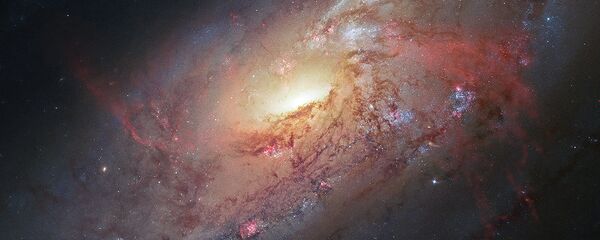Something strange is afoot three billion light-years from Earth in the distant Auriga constellation, as Fast Radio Bursts (FRBs) are continuously emitting from one of its dwarf galaxies. FRBs are a mysterious cosmic phenomenon that lasts only a few milliseconds, but release more energy than the sun does in an entire month.
Leading theories behind the cause of FRBs are cosmic catastrophes like stars colliding, or solar flares from a super-dense neutron star. Neither event is likely to occur in a small, otherwise inconsequential dwarf galaxy, however. "Why is this spectacular FRB in such a little, very innocent-looking galaxy?" asked Heino Falcke, a radio astronomer with Radboud University Nijmegen in the Netherlands. "There are many things coming together which don't make much sense yet."
An unexplained phenomenon in space? Must be aliens. "Fast radio bursts are exceedingly bright given their short duration and origin at great distances, and we haven't identified a possible natural source with any confidence," said study co-author Avi Loeb, in a Thursday statement. Loeb, a theorist at the Harvard-Smithsonian Center for Astrophysics, stated, "An artificial origin is worth contemplating and checking."
Loeb and study lead Manasvi Lingam, a Harvard astrophysicist, speculate that an advanced alien race could build a radio transmitter some 24,000 km (15,000 miles) in length that would collect sunlight to generate mind-boggling amounts of power. By comparison, our Earth has a diameter of just around 7,500 miles.
What would our aliens do with such technology? According to Loeb and Lingam, they could accelerate spacecraft to astonishing speeds. Alien ships would be equipped with light sails, enormous mirrors that gather sunlight and generate energy. The transmitter could be used to shoot the sails with a beam of energy to accelerate the spacecraft to a significant fraction of the speed of light. Human light sails remain experimental, mostly due to extreme engineering and financial challenges, but the science is sound.
"We examine the possibility that FRBs originate from the activity of extragalactic civilizations. Our analysis shows that beams used for powering large light sails could yield parameters that are consistent with FRBs," the Harvard team wrote. "The characteristic diameter of the beam emitter is estimated through a combination of energetic and engineering constraints, and both approaches intriguingly yield a similar result which is on the scale of a large rocky planet."
Lingam said in a statement that the transmitter could accelerate an interstellar spacecraft weighing 1 million tons. "That's big enough to carry living passengers across interstellar or even intergalactic distances," he said.
In comparison, NASA's gigantic Saturn V (the largest rocket ever launched) is just 3,100 tons. The fictional Starship Enterprise in the 2013 film Star Trek Into Darkness weighs about 500,000 tons, as estimated by Wired. That's a pretty big ship.
But before you call Will Smith and gear up for Independence Day, Lingam and Loeb want you to know that their study is only speculative. An advanced alien race is merely one of numerous possibilities.
"Science isn't a matter of belief; it's a matter of evidence," Loeb said. "Deciding what's likely, ahead of time, limits the possibilities. It's worth putting ideas out there and letting the data be the judge."





